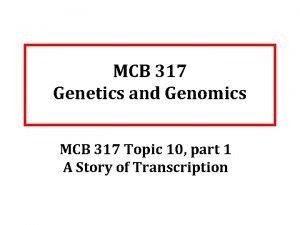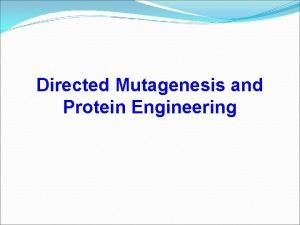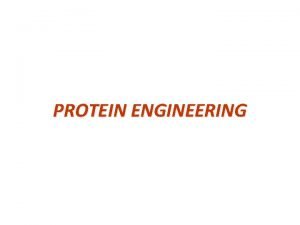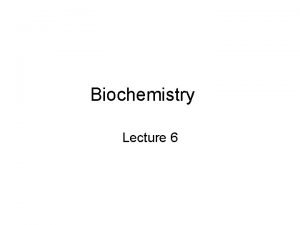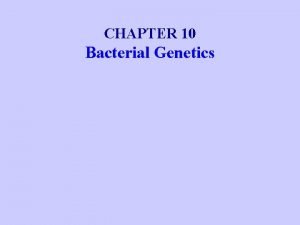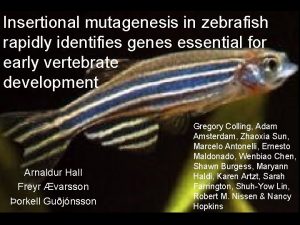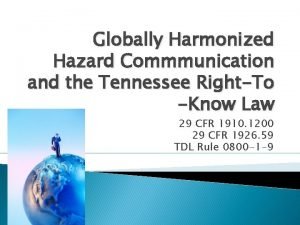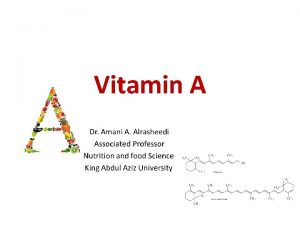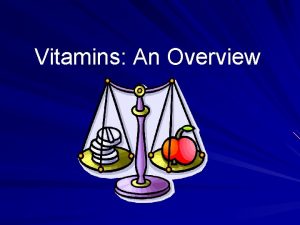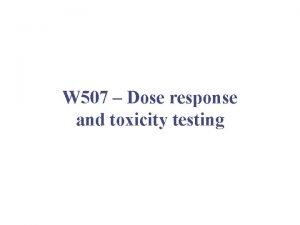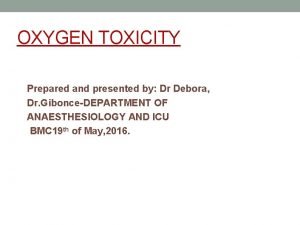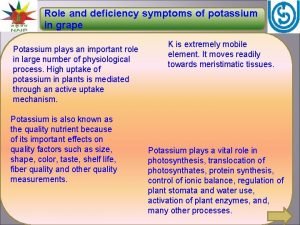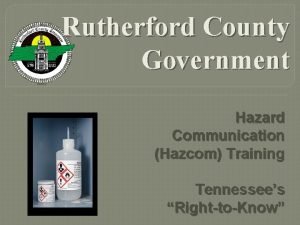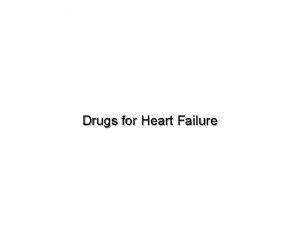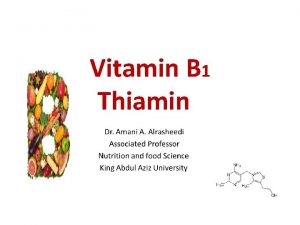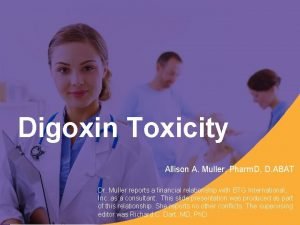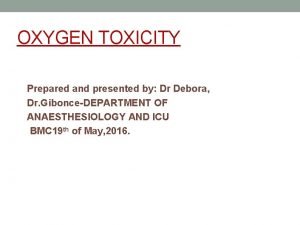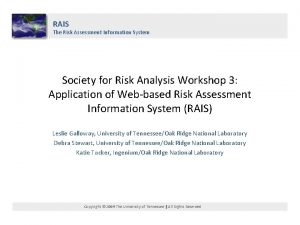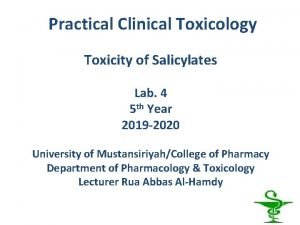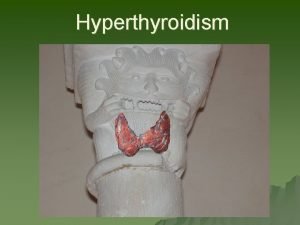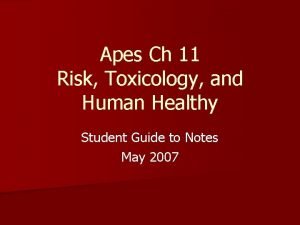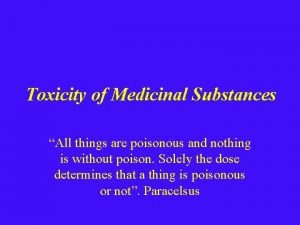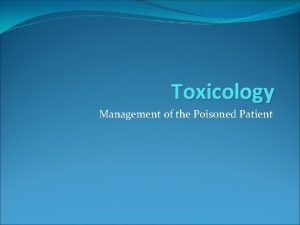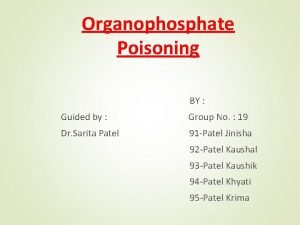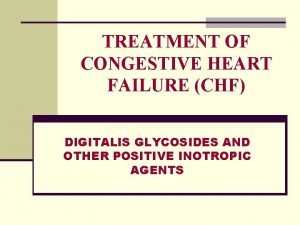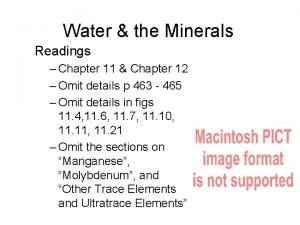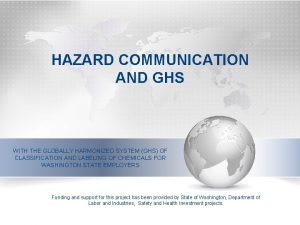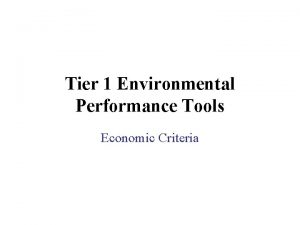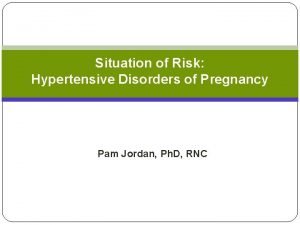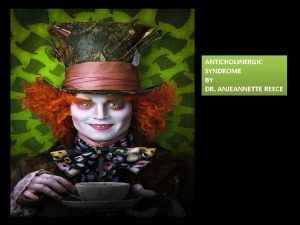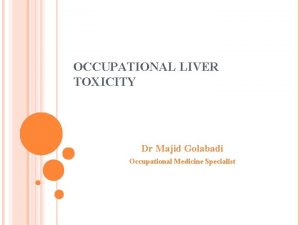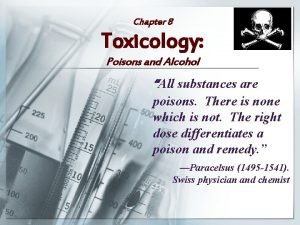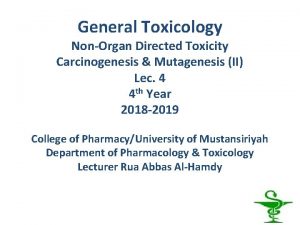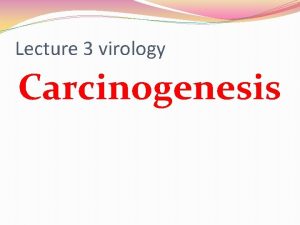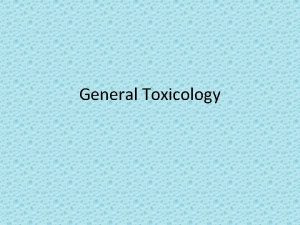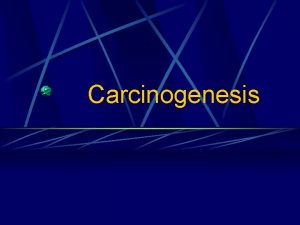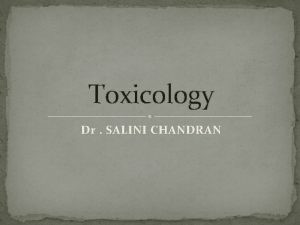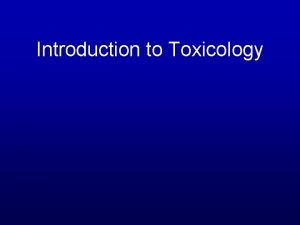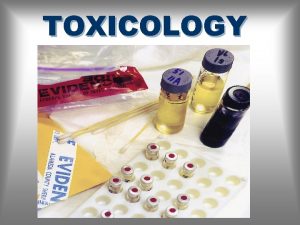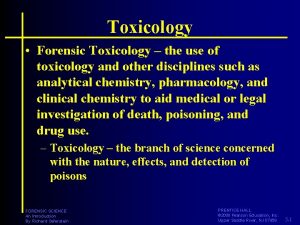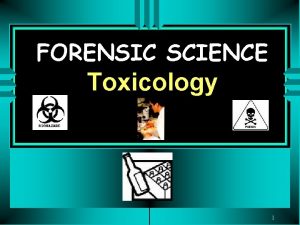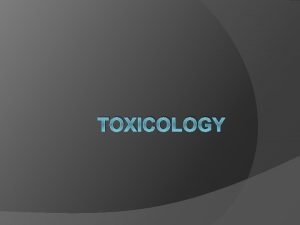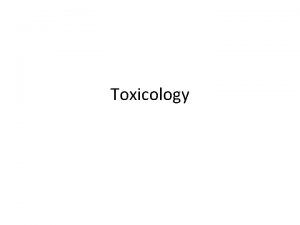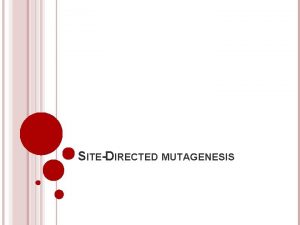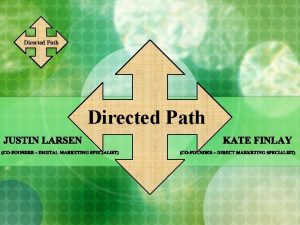General Toxicology NonOrgan Directed Toxicity Carcinogenesis Mutagenesis I











































- Slides: 43

General Toxicology Non-Organ Directed Toxicity Carcinogenesis & Mutagenesis (I) Lec. 3 4 th Year 2018 -2019 College of Pharmacy/University of Mustansiriyah Department of Pharmacology & Toxicology Lecturer Rua Abbas Al-Hamdy

Objectives of this lecture are to: § Define carcinogenesis & its stages. § Determine the modes of action of carcinogens. § Explain the modes of action & classes of genotoxic carcinogens. § Determine the modes of action of nongenotoxic carcinogens.

Carcinogenesis: § Cancer is a disease of cellular mutation, proliferation, & aberrant cell growth. § It ranks as one of the leading causes of death in the world. § Estimates suggest that 70% to 90% of all human cancers have a linkage to environmental, dietary, & behavioral factors.

Multistage carcinogenesis: Stages of carcinogenesis process involve: § initiation, § promotion, & § progression.

Initiation: § The first stage of the cancer process involves initiation, a process that is defined as a stable, heritable change. § This stage is a rapid, irreversible process that results in a carcinogen-induced mutational event. § Chemical & physical agents that interact with cellular components at this stage are referred to as initiators or initiating agents.

Promotion: § The second stage of the carcinogenesis process involves the selective clonal expansion of initiated cells to produce a preneoplastic lesion. § Both exogenous & endogenous agents that operate at this stage are referred to as tumor promoters. § Promotion is reversible upon removal of the promoting agent.

§ Tumor promoters generally show organ-specific effects, e. g. , a tumor promoter of the liver, such as phenobarbital, will not function as a tumor promoter in the skin or other tissues.

Progression: § Progression involves the conversion of benign preneoplastic lesions into neoplastic cancer. § The progression stage is irreversible in that neoplasm formation, whether benign or malignant, occurs. § With the formation of neoplasia, an autonomous growth &/or lack of growth control is achieved.

Mechanism of action of chemical carcinogens: Carcinogens have frequently been divided into two major categories (Fig. 1) based on their general mode of action: § Genotoxic & § Nongenotoxic carcinogens.

Modes of action of carcinogens Carcinogens Genotoxic carcinogens § Direct acting carcinogens § Indirect acting carcinogens Nongenotoxic carcinogens § § § Cytotoxicity Receptor mediated Hormonal mode of action DNA methylation Oxidative stress Figure 1. Modes of action of carcinogens

Genotoxic carcinogens: § They interact with DNA to damage or change its structure. § They are frequently mutagenic in a dose responsive manner.

Nongenotoxic carcinogens: § They are the agents that do not directly interact with nuclear DNA. § Nongenotoxic chemicals create a situation in a cell or tissue that makes it more susceptible to DNA damage from other sources.

Genotoxic/DNA-reactive carcinogens: DNA reactive carcinogens can be further subdivided according to whether: § they are active in their parent form (i. e. , directacting carcinogens— agents that can directly bind to DNA without being metabolized) & § those that require metabolic activation (i. e. , indirect-acting carcinogens—compounds that require metabolism in order to react with DNA).

Direct-acting (activation-independent) carcinogens: § Direct-acting carcinogens are highly reactive electrophilic molecules that can interact with & bind to nucleophiles, such as cellular macromolecules, including DNA without needing to be biotransformed into a reactive toxicant. § Generally, these highly reactive chemicals frequently result in tumor formation at the site of chemical exposure.

§ Direct-acting carcinogens include: Ø sulfur mustard (mustard gas), & nitrogen mustards (e. g. , chlorambucil , & cyclophosphamide). Ø epoxides, & Ø imines.

Indirect -acting genotoxic carcinogens: § The majority of DNA reactive carcinogens are found as parent compounds, or procarcinogens, chemicals that require subsequent metabolism to be carcinogenic. § Terms have been coined to define the parent compound (procarcinogen) & its metabolite form, either intermediate (proximate carcinogen) or final (ultimate carcinogen), that reacts with DNA.

§ Indirect-acting genotoxic carcinogens usually produce their neoplastic effects at the target tissue where the metabolic activation of the chemical occurs and not at the site of exposure (as with direct-acting genotoxic carcinogens). § Ø Ø Indirect-acting genotoxic carcinogens include: polycyclic polyaromatic hydrocarbons nitrosamines aromatic amines, & aflatoxin B 1.

Classes of genotoxic carcinogens: § Polyaromatic hydrocarbons § Alkylating agents § Aromatic amines & amides

Polyaromatic hydrocarbons: Polyaromatic hydrocarbons such as benzo(a)pyrene are found at high levels in charcoal broiled foods, cigarette smoke, & in diesel exhaust.

Alkylating agents: § Whereas some alkylating chemicals are directacting genotoxic agents, many require metabolic activation to produce electrophilic metabolites that can react with DNA. § The N 7 position of guanine & the N 3 position of adenine are the most reactive sites in DNA for alkylating chemicals.

Aromatic amines & amides: § Classically, exposure to these chemicals was through the dye industry, although exposure still occurs through cigarette smoke & other environmental sources. § The aromatic amines undergo phase-I (hydrolysis, reduction, & oxidation) & phase-II (conjugation) metabolism.

§ Phase-I reactions occur mainly by cytochrome P 450–mediated reactions, yielding hydroxylated metabolites. § These metabolites are often associated with adduct formation in proteins & DNA, & produce carcinogenicity.

Nongenotoxic (epigenetic) carcinogens: Modes of action of nongenotoxic (epigenetic) carcinogens are: § Cytotoxicity § Receptor mediated § Hormonal mode of action § DNA methylation & carcinogenesis § Oxidative Stress & chemical carcinogenesis

Cytotoxicity: § Chemicals that function through this mechanism produce sustained cell death that is accompanied by persistent regenerative growth (compensatory hyperplasia). § This results in the potential for the acquisition of “spontaneous” DNA mutations & allowing mutated cells to accumulate & proliferate.

§ Chloroform has been shown to induce mouse liver tumors only at doses of compound that produce liver necrosis, thus demonstrating an association between necrosis with compensatory hyperplasia & the resulting tumorigenicity. § The induction of cytotoxicity may be observed with many carcinogens both genotoxic & nongenotoxic when high toxic exposures occur.

Receptor mediated mechanism: § CAR receptor-mediated (phenobarbital-like carcinogens) § Peroxisome proliferator–activated receptor-α (PPARα )

CAR Receptor-Mediated (Phenobarbital-like carcinogens): § Phenobarbital is a commonly studied non-DNA reactive compound that is known to cause tumors by a nongenotoxic mechanism involving liver hyperplasia. § One feature seen following phenobarbital exposure is the induction of P 450 enzymes, particularly Cyp 2 b.

§ The induction of Cyp 2 b by phenobarbital is mediated by activation of the constitutive androstane receptor (CAR), a member of the nuclear receptor family.

Peroxisome proliferator–activated receptor-α (PPARα ): § Various chemicals are capable of increasing the number & volume of peroxisomes in the cytoplasm of cells. § These so-called peroxisome proliferators include chemicals such as herbicides, chlorinated solvents (e. g. , trichloroethylene), & lipid-lowering fibrate drugs (e. g. , ciprofibrate & clofibrate).

§ The currently accepted mode of action for this class of chemicals involves agonist binding to the nuclear hormone receptor, PPARα. § PPARα is highly expressed in cells that have active fatty acid oxidation capacity (e. g. , hepatocytes, cardiomyocytes, & enterocytes). § It is well documented that PPARα plays a central role in lipid metabolism.

Hormonal mode of action: § Hormonally active chemicals include biogenic amines, steroids, & peptide hormones that cause tissue-specific changes through interaction with a receptor. § Trophic hormones are known to induce cell proliferation at their target organs. § Estrogenic agents can induce tumors in estrogen-dependent tissue.

§ A number of chemicals that reduce thyroid hormone concentrations (T 4 &/or T 3) & increase thyroid-stimulating hormone (TSH) have been shown to induce neoplasia in the rodent thyroid.

DNA methylation & carcinogenesis: § Under normal conditions, DNA is methylated symmetrically on both strands. § The degree of methylation within a gene inversely correlates with the expression of that gene. § Several chemical carcinogens are known to modify DNA methylation, methyltransferase activity.

§ During carcinogenesis, both hypomethylation & hypermethylation of the genome have been observed. § Tumor-suppressor genes have been reported to be hypermethylated in tumors. § Hypomethylation has been associated with increased mutation rates.

§ Choline & methionine, which can be derived from dietary sources, provide a source of methyl groups used in methylation reactions. § Rats exposed to choline &/or methioninedeficient diets resulted in hepatocellular proliferation & neoplasia thought to arise from hypomethylation. § Reactive oxygen species have also been shown to modify DNA methylation by interfering with the ability of methyltransferases to interact with DNA; resulting in hypomethylation.

Oxidative stress & chemical carcinogenesis: § Oxygen radicals can be produced by both endogenous & exogenous sources & are typically counterbalanced by antioxidants. § Antioxidant defenses are both enzymatic (e. g. , superoxide dismutase, glutathione peroxidase, & catalase) & nonenzymatic (e. g. , vitamin E, vitamin C, β-carotene, & glutathione).

§ Endogenous sources of reactive oxygen species include oxidative phosphorylation, P 450 metabolism, peroxisomes, & inflammatory cell activation. § Through these or other currently unknown mechanisms, a number of chemicals that induce cancer (e. g. , chlorinated compounds, radiation, metal ions, barbiturates, & some PPARα agonists) induce reactive oxygen species formation.

§ Reactive oxygen species could result in oxidative DNA damage, & could also affect cell growth regulation.

Oxidative DNA damage & carcinogenesis: § In DNA, reactive oxygen species can produce single- or double-stranded DNA breaks, purine, pyrimidine, & DNA crosslinks. § Compared to nuclear DNA, the mitochondrial DNA is relatively susceptible to oxidative base damage due to:

(1) close proximity to the electron transport system, a major source of reactive oxygen species; (2) mitochondrial DNA is not protected by histones; & (3) DNA repair capacity is limited in the mitochondria.

Oxidative stress & cell growth regulation: § Many xenobiotics, by increasing cellular levels of oxidants, alter gene expression through activation of signaling pathways including: Ø cyclic adenosine monophosphate (c. AMP)mediated cascades, Ø calcium-calmodulin pathways, & Ø signaling through mitogen-activated protein (MAP) kinases.

§ Activation of these signaling cascades ultimately leads to altered gene expression for a number of genes including those affecting proliferation, differentiation, & apoptosis.

 Mcb 317
Mcb 317 Directed mutagenesis and protein engineering
Directed mutagenesis and protein engineering Gene shuffling
Gene shuffling Glycosidic bond
Glycosidic bond Syntax directed definition and syntax directed translation
Syntax directed definition and syntax directed translation Mutagenesis definition biology
Mutagenesis definition biology Mutagénesis dirigida
Mutagénesis dirigida Insertional mutagenesis
Insertional mutagenesis Insertional mutagenesis
Insertional mutagenesis Acute toxicity
Acute toxicity Functions of vitamin a
Functions of vitamin a Vitamin d toxicity
Vitamin d toxicity W 507
W 507 Definition of chronic toxicity
Definition of chronic toxicity Early signs of oxygen toxicity
Early signs of oxygen toxicity Potassium toxicity symptoms in plants
Potassium toxicity symptoms in plants Acute toxicity
Acute toxicity Alcohol toxicity
Alcohol toxicity Lithium toxicity
Lithium toxicity Digoxin toxicity mnemonic
Digoxin toxicity mnemonic Definition of chronic toxicity
Definition of chronic toxicity Beri beri
Beri beri Digoxin mechanism of action
Digoxin mechanism of action What is oxygen toxicity
What is oxygen toxicity Rais calculator
Rais calculator Treatment of salicylate toxicity
Treatment of salicylate toxicity Vitamin c toxicity
Vitamin c toxicity Thyroid resistance syndrome
Thyroid resistance syndrome Apes chapter 11
Apes chapter 11 Vitamin a toxicity
Vitamin a toxicity Lithium toxicity
Lithium toxicity Apap
Apap Organophosphate toxicity
Organophosphate toxicity Mountains into molehills answer key
Mountains into molehills answer key Digoxin toxicity symptoms
Digoxin toxicity symptoms B6 toxicity symptoms
B6 toxicity symptoms Zinc toxicity
Zinc toxicity Which pictogram represents acute toxicity
Which pictogram represents acute toxicity Toxicity index
Toxicity index Magnesium sulfate toxicity level
Magnesium sulfate toxicity level Anticholinergic toxicity mnemonic
Anticholinergic toxicity mnemonic Hepatic toxicity
Hepatic toxicity Chapter 8 toxicology poisons and alcohol
Chapter 8 toxicology poisons and alcohol Drug identification and toxicology
Drug identification and toxicology
